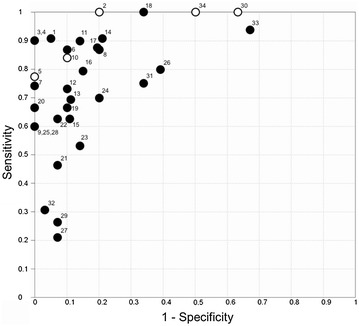Fig. 2.

Receiver operating characteristics curve with all methods found in the literature search of assessment volume responsiveness in spontaneous breathing patients. Closed circles represent studies including spontaneous breathing patients without ventilator support; open circles represent studies including patients under mechanical ventilation during spontaneous mode and spontaneous breathing without ventilator support. 1 = ∆PPV of 52%; 2 = ∆SV-PLRTTE >13%; 3 = ∆PPdim ≥12%; 4 = ∆VFdim ≥12%; 5 = SVi-PLR ≥12.5%; 6 = ∆SV-PLR ≥10%; 7 = ∆VTI-PLR >12%; 8 = ∆VF-PLR ≥8%; 9 = ∆SV ≥17%; 10 = ∆SV-PLRFloT >16%; 11 = ∆PPFB = 13.7%; 12 = ∆VSP of 30%; 13 = ∆SV >12%; 14 = PPmin of 45mmHg; 15 = ∆CO >12%; 16 = ∆PP-PLR ≥9%; 17 = cIVC of 25%; 18 = cIVC ≥15%; 19 = E wave velocity of 0.7; 20 = VTI ≤21cm; 21 = ∆SP of 9%; 22 = ∆PP of 12%; 23 = ΔCO-PLR >10%; 24 = cIVC =40%; 25 = ∆VF ≥10%; 26 = ∆SV-PLR; 27 = ∆PPf of 33%; 28 = ∆PP ≥10%; 29 = ∆SPf of 30%; 30 = ∆PP ≥11%; 31 = AoVV ≥25%; 32 = cIVC >42%, 33 = IVCmax <2.1cm, 34 = ∆SV≥10%
